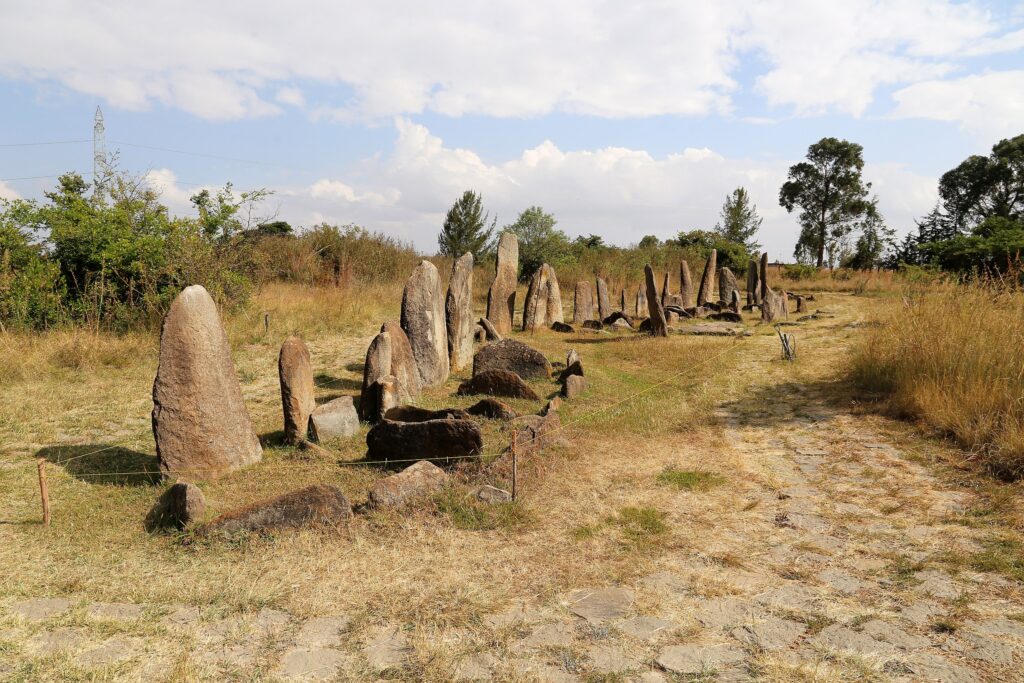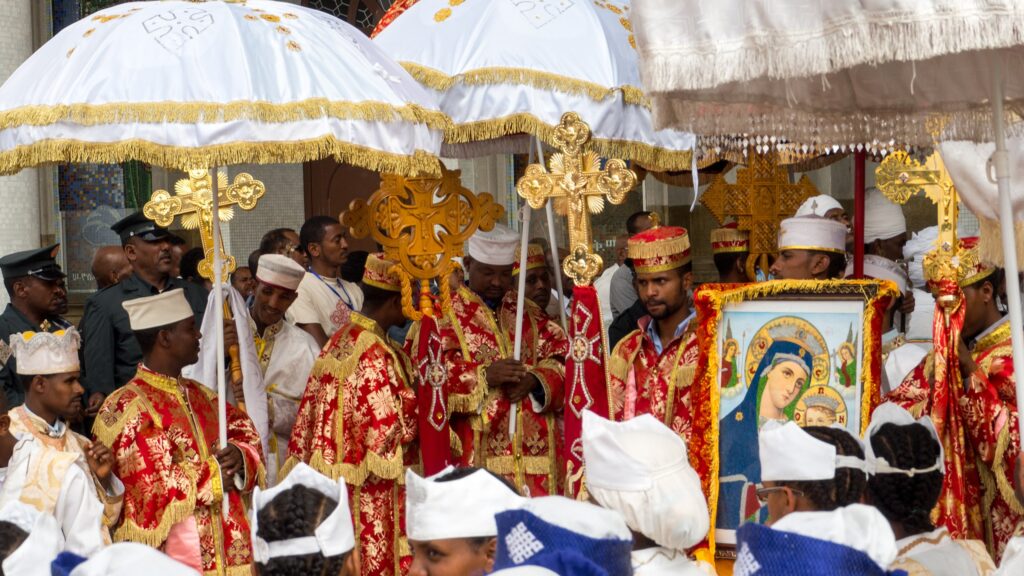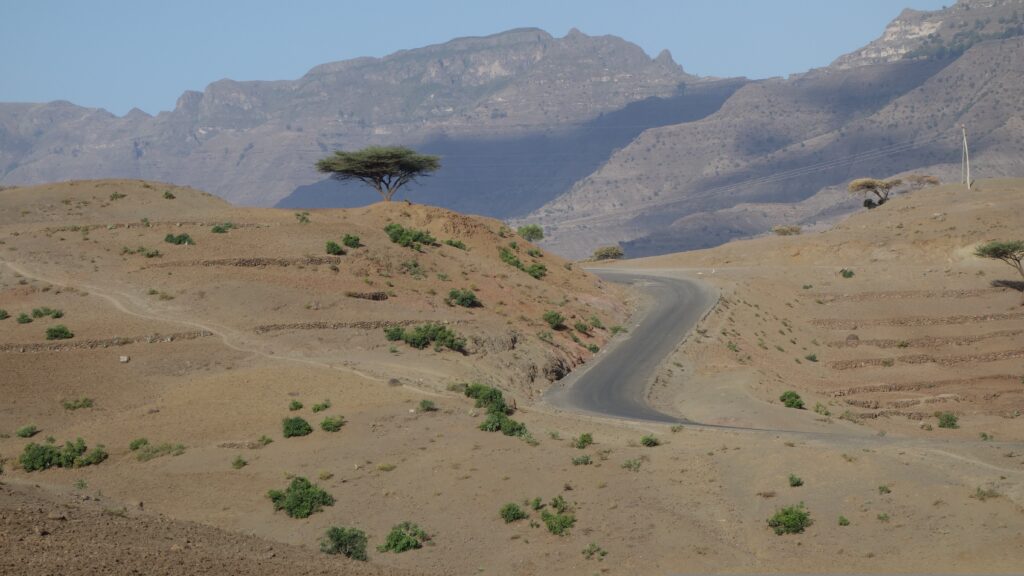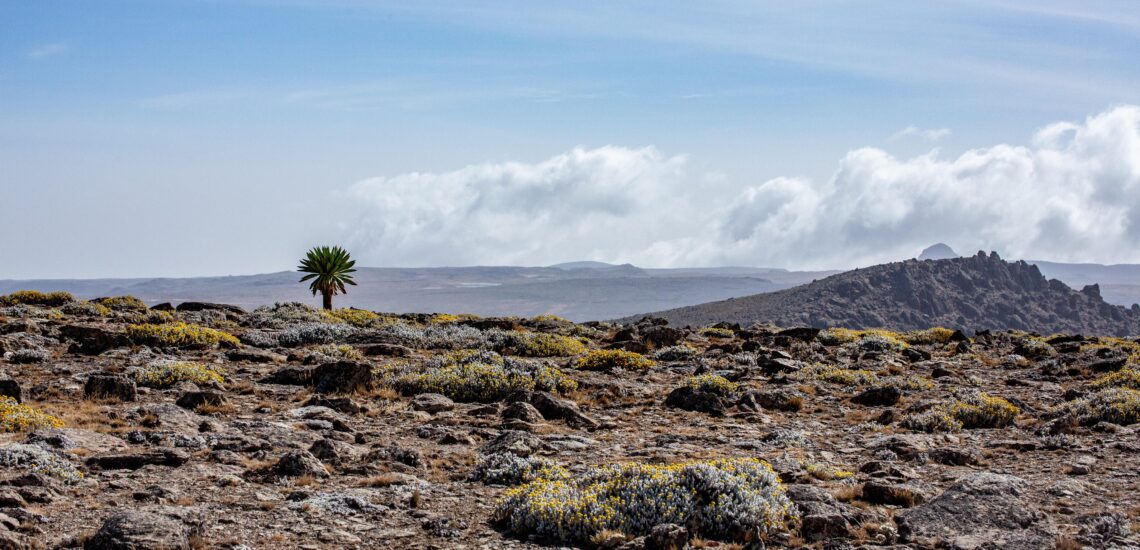Quick facts about Ethiopia:
- Population: Approximately 126 million people.
- Capital: Addis Ababa.
- Official Language: Amharic.
- Other Languages: Over 80 ethnic languages are spoken, including Oromo, Tigrinya, and Somali.
- Currency: Ethiopian Birr (ETB).
- Government: Federal parliamentary republic.
- Major Religion: Christianity (predominantly Ethiopian Orthodox), with significant Muslim and Protestant minorities.
- Geography: Located in the Horn of Africa, bordered by Eritrea to the north, Sudan to the northwest, South Sudan to the west, Kenya to the south, and Somalia to the east. It has highlands, plateaus, and the Great Rift Valley.
Fact 1: Ethiopia is the birthplace of coffee
According to legend, coffee was discovered in the Ethiopian region of Kaffa by a goat herder named Kaldi in the 9th century. Kaldi noticed that his goats became unusually energetic after eating the red berries from a particular tree. Curious, he tried the berries himself and experienced a similar burst of energy. This discovery eventually led to the cultivation of coffee and its spread throughout the world.
Today, coffee is a significant part of Ethiopian culture and economy, with the country producing some of the finest and most distinctive coffee varieties globally, such as Yirgacheffe, Sidamo, and Harrar.

Fact 2: Ethiopia has a unique calendar and timekeeping system
Ethiopia has a unique calendar and timekeeping system that sets it apart from most of the world.
Ethiopian Calendar:
- Calendar System: Ethiopia uses its own calendar, which is based on the Coptic or Ge’ez calendar. It has 13 months: 12 months of 30 days each and a 13th month called “Pagumē,” which has 5 or 6 days, depending on whether it’s a leap year.
- Year Difference: The Ethiopian calendar is about 7 to 8 years behind the Gregorian calendar used in most of the world. For example, while it is 2024 in the Gregorian calendar, it is 2016 or 2017 in Ethiopia, depending on the specific date.
- New Year: The Ethiopian New Year, known as “Enkutatash,” falls on September 11th (or 12th in a leap year) in the Gregorian calendar.
Ethiopian Timekeeping:
- 12-Hour Day System: Ethiopia uses a 12-hour clock system, but the hours are counted differently. The day starts at what would be 6:00 AM in the Gregorian system, which is called 12:00 in Ethiopian time. This means 1:00 Ethiopian time corresponds to 7:00 AM in the Gregorian system, and so on. The night starts at what would be 6:00 PM in the Gregorian system, also called 12:00 Ethiopian time.
- Daylight Hours: This system aligns more closely with the natural day, where the day begins at sunrise and ends at sunset, a practical system for an agrarian society.
Fact 3: Ethiopia heir to the ancient Empire of Aksum
Ethiopia is considered the heir to the ancient Empire of Aksum, a powerful and influential civilization that flourished from around the 1st to the 10th century AD. The Aksumite Empire was a dominant force in the Horn of Africa, controlling important trade routes that connected Africa to the Middle East and beyond. It was one of the first regions in the world to adopt Christianity, which became the official religion in the 4th century under King Ezana. The legacy of Aksum is still visible in Ethiopia today, particularly through the Ethiopian Orthodox Church and the use of the Ge’ez script, which originated in Aksum. The empire is also renowned for its monumental stelae and obelisks, which are considered some of the greatest achievements of ancient African architecture. Aksum’s historical significance, including its ties to the Queen of Sheba and the Ark of the Covenant, has cemented its place as a foundational element of Ethiopia’s national identity.

Fact 4: Ethiopia is rich in vegetarian cuisine
Ethiopia is renowned for its rich and diverse vegetarian cuisine, which is deeply rooted in the country’s culture and religious practices. A significant portion of the Ethiopian population follows the Ethiopian Orthodox Church, which prescribes regular fasting days where followers abstain from eating animal products. As a result, Ethiopian cuisine features a wide variety of flavorful and nutritious vegetarian dishes.
One of the most famous elements of Ethiopian cuisine is injera, a large, sourdough flatbread made from teff, a gluten-free grain native to Ethiopia. Injera is often served as the base for a communal meal, with various stews and dishes placed on top. Vegetarian dishes typically include shiro wat (a spiced chickpea or bean stew), misir wat (a lentil stew cooked with spices), atkilt wat (a stew made from cabbage, potatoes, and carrots), and gomen (sautéed collard greens).
Fact 5: Ethiopia has 9 UNESCO World Heritage sites
Ethiopia is home to nine UNESCO World Heritage Sites, reflecting its rich history, cultural significance, and natural beauty. These sites are spread across the country and represent various aspects of Ethiopia’s ancient civilizations, religious heritage, and natural landscapes.
- Aksum: The ruins of the ancient city of Aksum, once the center of the Aksumite Empire, include obelisks, tombs, and the ruins of castles. This site is also traditionally associated with the Ark of the Covenant.
- Rock-Hewn Churches of Lalibela: These 11 medieval churches, carved out of rock in the 12th century, are still in use today. Lalibela is a major pilgrimage site for Ethiopian Orthodox Christians.
- Harar Jugol, the Old City of Harar: Known as the “City of Saints,” Harar is considered the fourth holiest city of Islam. It features 82 mosques, three of which date back to the 10th century, and over 100 shrines.
- Tiya: This archaeological site features a large number of stelae, including 36 carved standing stones that are believed to mark graves.
- Lower Valley of the Awash: This site is where the famous early hominid fossil “Lucy” (Australopithecus afarensis) was discovered, providing crucial insights into human evolution.
- Lower Valley of the Omo: Another significant archaeological site, the Omo Valley has yielded numerous fossils that contribute to the understanding of early human history.
- Simien Mountains National Park: This park is known for its dramatic landscapes, including jagged mountain peaks, deep valleys, and sharp precipices. It’s also home to rare animals like the Ethiopian wolf and the Gelada baboon.
- Afar Triple Junction (Erta Ale and the Danakil Depression): The Erta Ale volcano and the Danakil Depression, one of the hottest places on Earth, are part of this geological site known for its active volcanic activity and unique mineral formations.
- Konso Cultural Landscape: The Konso area features terraced hillsides and stone steles (waka) erected to honor local heroes and leaders. The landscape is an example of a traditional, sustainable land use system.

Fact 6: Ethiopia is the first Christian country
Ethiopia is one of the earliest countries to adopt Christianity, with the Ethiopian Orthodox Church playing a central role in the nation’s history. Christianity became the state religion in the 4th century under King Ezana of the Aksumite Empire. The Ethiopian Bible is one of the oldest and most complete versions of the Christian Bible, containing 81 books, including texts not found in most other Christian traditions, such as the Book of Enoch and the Book of Jubilees. Written in the ancient Ge’ez language, the Ethiopian Bible has remained distinct from European versions of Christianity. The Ethiopian Orthodox Church, with its unique traditions and practices, including its own liturgical calendar and religious customs, has preserved a form of Christianity that has remained largely unchanged for centuries. This rich religious heritage highlights Ethiopia’s significant and enduring contribution to Christian history.
Fact 7: An annual festival is held in Ethiopia to commemorate the baptism of Jesus
Ethiopia hosts an annual festival called Timkat (or Epiphany), which commemorates the baptism of Jesus Christ. Timkat, meaning “The Baptism,” is one of the most important religious festivals in the Ethiopian Orthodox Church and is celebrated on January 19th (or 20th in a leap year) in accordance with the Ethiopian calendar.During Timkat, thousands of Ethiopians gather to participate in vibrant and joyous ceremonies. The festival features processions, where replicas of the Ark of the Covenant, called Tabots, are carried in elaborate processions from churches to a body of water, such as a river or lake. The water is then blessed in a ritual that symbolizes the baptism of Jesus. This is followed by a period of immersion and sprinkling, reflecting the baptismal rites.

Fact 8: More than 80 languages are spoken in Ethiopia
Ethiopia is incredibly linguistically diverse, with over 80 languages spoken across the country. These languages belong to several major language families, including Afroasiatic, Nilo-Saharan, and Omotic.
The most widely spoken languages include Amharic, which is the official working language of the federal government; Oromo, which is spoken by the Oromo people and is one of the largest ethnic groups in the country; and Tigrinya, spoken primarily in the Tigray region. Other notable languages include Somali, Afar, and Sidamo.
Fact 9: Ethiopia is a very mountainous country
The nation’s landscape is dominated by the Ethiopian Highlands, which cover much of the central and northern regions. This rugged terrain features some of Africa’s highest peaks and most dramatic landscapes.
The Ethiopian Highlands are characterized by extensive plateaus, deep valleys, and steep escarpments. These highlands are often referred to as the Roof of Africa due to their elevation and prominence. Notable features include the Simien Mountains, known for their sharp peaks and deep gorges, and the Bale Mountains, which are famous for their alpine meadows and unique ecosystems.
The mountainous terrain significantly influences Ethiopia’s climate, hydrology, and agriculture. It creates a variety of microclimates and supports diverse flora and fauna, contributing to the country’s rich biodiversity.

Note: If you plan to visit the country, check the need for an International Driving Permit in Ethiopia for renting and driving a car.
Fact 10: Ethiopia has its own alphabet
Ethiopia has its own unique script known as Ge’ez or Ethiopic. This script is one of the oldest in the world and is used primarily for liturgical purposes in the Ethiopian Orthodox Church and also for several modern Ethiopian languages.
The Ge’ez script is an abugida, which means that each character represents a consonant with an inherent vowel sound that can be changed by modifying the character. The script has evolved over centuries and is used for writing languages such as Amharic, Tigrinya, and Ge’ez itself.

Published September 01, 2024 • 9m to read





